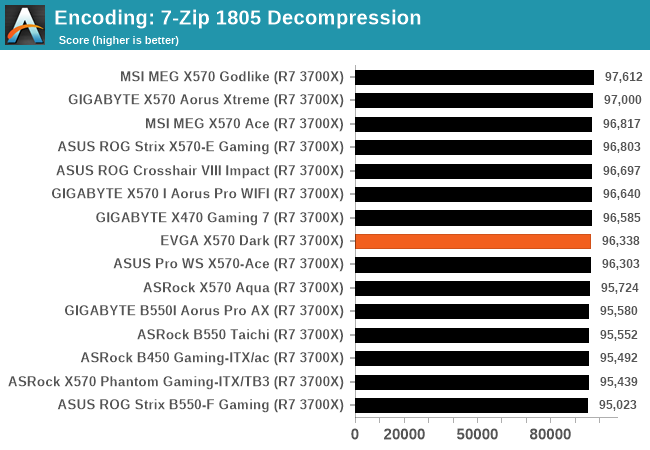The EVGA X570 Dark Motherboard Review: A Dark Beast For Ryzen
by Gavin Bonshor on October 8, 2021 8:00 AM ESTCPU Performance, Short Form
For our motherboard reviews, we use our short form testing method. These tests usually focus on if a motherboard is using MultiCore Turbo (the feature used to have maximum turbo on at all times, giving a frequency advantage), or if there are slight gains to be had from tweaking the firmware. We put the memory settings at the CPU manufacturers suggested frequency, making it very easy to see which motherboards have MCT enabled by default.
Rendering - Blender 2.79b: 3D Creation Suite - link
A high profile rendering tool, Blender is open-source allowing for massive amounts of configurability, and is used by a number of high-profile animation studios worldwide. The organization recently released a Blender benchmark package, a couple of weeks after we had narrowed our Blender test for our new suite, however their test can take over an hour. For our results, we run one of the sub-tests in that suite through the command line - a standard ‘bmw27’ scene in CPU only mode, and measure the time to complete the render.

Rendering – POV-Ray 3.7.1: Ray Tracing - link
The Persistence of Vision Ray Tracer, or POV-Ray, is a freeware package for as the name suggests, ray tracing. It is a pure renderer, rather than modeling software, but the latest beta version contains a handy benchmark for stressing all processing threads on a platform. We have been using this test in motherboard reviews to test memory stability at various CPU speeds to good effect – if it passes the test, the IMC in the CPU is stable for a given CPU speed. As a CPU test, it runs for approximately 1-2 minutes on high-end platforms.

Compression – WinRAR 5.60b3: link
Our WinRAR test from 2013 is updated to the latest version of WinRAR at the start of 2014. We compress a set of 2867 files across 320 folders totaling 1.52 GB in size – 95% of these files are small typical website files, and the rest (90% of the size) are small 30-second 720p videos.

Synthetic – 7-Zip v1805: link
Out of our compression/decompression tool tests, 7-zip is the most requested and comes with a built-in benchmark. For our test suite, we’ve pulled the latest version of the software and we run the benchmark from the command line, reporting the compression, decompression, and a combined score.
It is noted in this benchmark that the latest multi-die processors have very bi-modal performance between compression and decompression, performing well in one and badly in the other. There are also discussions around how the Windows Scheduler is implementing every thread. As we get more results, it will be interesting to see how this plays out.



Point Calculations – 3D Movement Algorithm Test: link
3DPM is a self-penned benchmark, taking basic 3D movement algorithms used in Brownian Motion simulations and testing them for speed. High floating point performance, MHz, and IPC win in the single thread version, whereas the multithread version has to handle the threads and loves more cores. For a brief explanation of the platform agnostic coding behind this benchmark, see my forum post here.











36 Comments
View All Comments
Oxford Guy - Monday, October 11, 2021 - link
What’s not is how MSI raised prices.supdawgwtfd - Friday, October 8, 2021 - link
"Touching on the performance with is almost certainly EVGA's primary focus here"Umm... What?
Anandtech still doesn't have a basic proof reader person to check through articles before release it seems.
TheITS - Saturday, October 9, 2021 - link
"As per our testing policy, we take a high-end CPU suitable for the motherboard released during the socket’s initial launch"Maybe your policies need updating so the reviews can be more useful to your customers. The 3700X was never a high end CPU anyway? Either Zen 2 and Zen 3 behave the same and you aren't invalidating your previous work by using a chip people will actually put in the thing, or they do behave differently in which case you just wasted all that time reviewing a product with a CPU no one will pair with it.
Oxford Guy - Saturday, October 9, 2021 - link
'extreme overclocking'An anachronism.
LtGoonRush - Sunday, October 10, 2021 - link
Wow, what a shameful display for a supposedly high-end, overclocking focused motherboard. That DPC latency is outright disqualifying, and the fact that they can't design a VRM without active cooling is just embarrassing. I really wanted to like this board and see a new entrant in the motherboard space, but this product absolutely should have been canceled before seeing the light of day. Along with their recent issues with exploding RTX 3000 cards it's starting to seem like EVGA is a brand to avoid.Midland_Dog - Monday, October 11, 2021 - link
still no memory overclocking segment, this review is as useless as the asrock z590 oneno one cares what cpu frequency it does. a mediocre board will do the same cpu frequency, only reason you wont hit that frequency is because the board is so far away from decent that it shouldnt be sold
MEMORY OC IS THE MAIN REASON THESE BOARDS HAVE ANY ADVANTAGE IN COMPETITIVE OC
a great analogy for this review is that you are "seeing how much an F1 car can tow"
every board thats worth owning will hit the same cpu frequency. for all we know b550 boards can score better than this because you havent tested memory OC. get yourselves a good kit of dual rank b-die and please test what its ACTUALLY made for. as far as im concerned this is a useless reviewq/